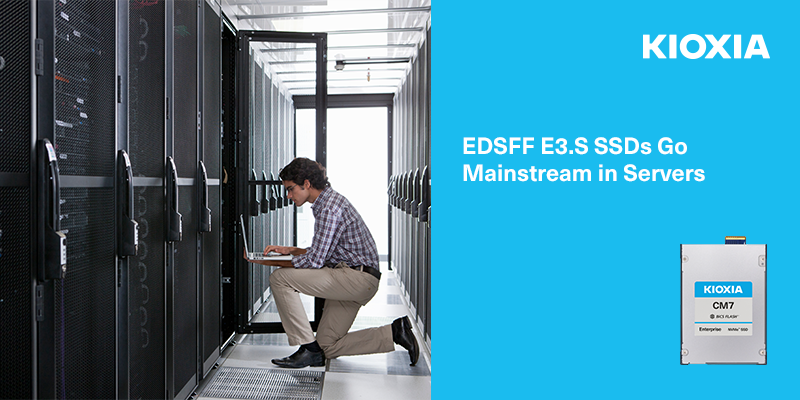
The 2.5-inch and M.2 form factors have been the standard for data center servers and storage for many years. 2.5-inch was originally created for HDDs and M.2 was created for flash memory in low capacities. Enterprise and Datacenter Standard Form Factor (EDSFF) is a set of new SSD form factor specifications created for SSDs that solves the inherent shortcomings of legacy form factors - and enables the server and storage systems of tomorrow. Thanks to EDSFF E3.S SSDs from KIOXIA and E3.S-enabled servers from Dell Technologies, the future is now!
KIOXIA has developed data center PCIe® NVMe™ SSDs with an EDSFF E3.S option that will be available on select new Dell PowerEdge 16G servers that support the PCIe 5.0 interface with E3.S backplanes. While EDSFF E3.S is still very new, there are several great resources available for IT admins and customers looking to learn everything they need to know about what makes E3.S drives a great fit for current and future generations of servers. KIOXIA and Dell worked together on an EDSFF E3.S overview white paper that provides great insight as to the benefits, specifications and form factor options. KIOXIA also has an EDSFF microsite that has even more information on both E3 and E1 form factors, including videos, an infographic, industry articles, and more.
KIOXIA has been working with Dell Technologies for decades to provide leading storage innovations to market – and we’re especially excited about this latest innovation. Dell’s Jonathan Seckler, Sr. Director of Product Marketing, authored a blog about Dell’s new PowerEdge EDSFF E3.S capable servers. Jonathan’s blog includes details on when you’ll see these next-gen servers become available.
We’ll send out more EDSFF E3.S updates and product news as they become available. Follow us on Twitter and LinkedIn® to stay on top of breaking news and information from KIOXIA.
Dell Technologies and PowerEdge are trademarks of Dell Inc. in the U.S. and/or other jurisdictions.
PCI Express and PCIe are registered trademarks of PCI-SIG.
The NVMe word mark is a registered and unregistered trademark and service mark of NVM Express, Inc.
LinkedIn is a trademark of LinkedIn Corporation and its affiliates in the United States and/or other countries.
2.5-inch indicates the form factor of the SSD and not its physical size.
Definition of capacity: KIOXIA Corporation defines a megabyte (MB) as 1,000,000 bytes, a gigabyte (GB) as 1,000,000,000 bytes and a terabyte (TB) as 1,000,000,000,000 bytes. A computer operating system, however, reports storage capacity using powers of 2 for the definition of 1Gb = 2^30 bits = 1,073,741,824 bits, 1GB = 2^30 bytes = 1,073,741,824 bytes and 1TB = 2^40 bytes = 1,099,511,627,776 bytes and therefore shows less storage capacity. Available storage capacity (including examples of various media files) will vary based on file size, formatting, settings, software and operating system, and/or pre-installed software applications, or media content. Actual formatted capacity may vary.